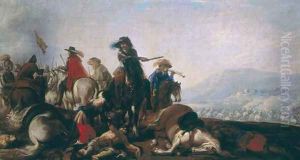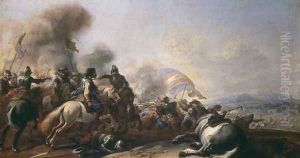Il Borgognone Paintings
Il Borgognone, whose real name was Jacques Courtois, was a French-born painter who spent most of his career in Italy and was known for his contributions to the Baroque period. He was born in Saint-Hippolyte, near Besançon, in France, in 1621. His nickname 'Il Borgognone' or 'Bourguignon' means 'the Burgundian', a reference to his place of origin.
Courtois initially received artistic training from his father, Jean Courtois, who was also a painter. In pursuit of further artistic development, he joined the army, where he had first-hand experience of military life that would later heavily influence his work, particularly in his depictions of battle scenes, for which he is most known.
After his military stint, Courtois moved to Milan around 1639, where he studied under the battle painter Pier Francesco Mazzucchelli (also known as il Morazzone). He went on to Rome, where he came into contact with the works of great masters like Pietro da Cortona and was influenced by the dynamic style of the Roman Baroque. His work was also influenced by the Venetian school, particularly the art of Paolo Veronese.
In Rome, Il Borgognone's reputation grew, and his battle scenes gained him recognition and commissions from prestigious patrons, including members of the clergy and Italian nobility. His paintings were celebrated for their vigorous movement, dramatic use of light, and the skillful portrayal of horses and soldiers in combat. His mastery in rendering the chaos and frenzy of battlefields set him apart from many of his contemporaries.
Il Borgognone later joined the Jesuit Order in 1655, and spent the last years of his life in Rome, where he produced works for Jesuit establishments. His religious affiliation did not significantly alter the nature of his work, as he continued to paint battle scenes with the same fervor.
Jacques Courtois died in Rome on November 14, 1665. After his death, his brother, Guillaume Courtois (known as il Borgognone or Guglielmo Cortese), who was a notable painter in his own right, continued to promote Jacques' legacy. Today, Il Borgognone's works are held in many prestigious collections and continue to be studied for their contribution to the Baroque style and their unique depiction of military subjects.

